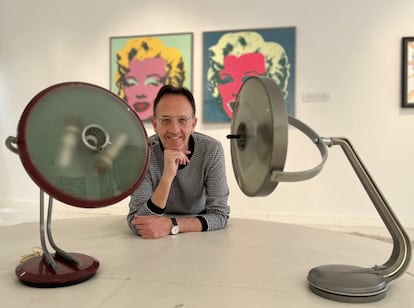The Fase lamp: 60 years of the design icon that is always in fashion
Used to decorate the sets of ‘Mad Men’ and ‘Indiana Jones’ these table lamps are a coveted collector’s item. Researcher Óscar Jiménez is a Fase expert and gives us the keys to its success

Of all the collectors and experts, Óscar Jiménez, university professor and researcher in Translation and Interpretation, is a Fase luminary. He began collecting the lamps in 2014 as a way to reveal all kinds of anecdotes. He combed through the avatars of its two founders and investigated the international success of these luminaries, which soon made the leap to the United States and became famous. All these years of work and effort on this collection of lamps has earned Jiménez a place as a member of the Chair of Innovation in Crafts, Design and Contemporary Art of the University of Granada (Spain).
In his passion for research, Jiménez has managed to create a systematic collection of pieces. He has more than 200 lamps and more than 100 different models — among which he has a special weakness for the Torpedo model (he has eight or nine of them), designed by Tomás Díaz Magro. His ultimate goal is to set up a museum that reflects the care with which he has been accumulating the stories that go with each lamp in the collection. “I would like them not to be scattered, and it would be good for an institution to buy or rent the collection so that they could be displayed together. The National Museum of Decorative Arts in Madrid has shown in interest” in doing so, he says.
How did an icon so unknown until recently become a coveted collector’s item? The answer is found in Fase, The Book, which, in its 360 pages, details the entire history of the company, its founders and designers. The book’s subtitle The mystery solved hints that, in addition to being “dedicated to recovering the lamp’s memory and reclaiming its legacy” as indicated by its authors, Óscar Jiménez Serrano and Juan Luis Gómez Frieiro, it also gives names, surnames, and a date of creation to many Fase models that were anonymous until now. It constitutes the “only existing critical catalog of Fase lamps, along with detailed information on its associated brands (Lupela, GEI, Grin Luz, Ma-Of),” according to Jiménez, “and is prefaced by Claudette Didul, art director of the series Mad Men, which placed the lamp in the protagonist Don Draper’s office,” he adds.
This book has become a design object in itself for which collectors have paid up to €500. Without a doubt, it has served to put the lamps that are part of the collective imagination of several generations in the spotlight. The Fase lamps, whose timeless design is now an object of desire for lighting enthusiasts and collectors in general, appeal to our sense of nostalgia because they were the typical cheap office and desk lamps that our grandparents and parents had in their homes in the 1960s and 1970s.
Tomás Díaz Magro signs some of the most successful Fase designs, such as Torpedo, Apolo, Minifase, and Sauce. “The true success of the brand was the spring lamps made by some brave men who plucked Spain out of anonymity and brought the designs to Canada and Japan,” explains Jiménez. Those brave people are Pedro Martín and Luis Pérez de la Oliva, “the two who patented the Presidente lamp on May 31, 1963 (which has just turned 60),” says Jiménez. “They patented the lamp before setting up the Fase company in Madrid in 1964 and, as its anniversary will also be celebrated in 2024, I would like to organize several activities around this international phenomenon due to Pedro Martín’s entrepreneurial instinct.” For Jiménez, “this great commercial visionary made it possible to export Fase lamps to half the world, in fact, many of them are found abroad, and Martín even opened a branch in the United States in the seventies,” he says. The marketinian look consisted of adding a Fase lamp to the furniture equipment pack that an office or office needed and, in this way, the lamp accessory became more and more ubiquitous.
This expert in Fase unravels a frequent phenomenon in manufacturer sagas and that is that “Fernando Martín (Pedro’s brother) was the owner of Lupela, another leading brand of office lamps in Spain in the sixties. It was one of Fase’s competitors in manufacturing [and part of] an interesting story that has parallels with Adidas and Puma, and that represents two brothers competing for the same market,” he says.
One might wonder why Fase lamps are so photogenic, from the classic sprung lamp that every grade student had on their desk to the six Fase models that appear in the film Killing El Nani or appearances in series such as Valeria, Supergarcía or telenovelas such as Amar es para siempre. “They are photogenic and timeless, their design is attractive and in the cinema they are used more as sculptures, which is why art directors have fallen in love with them and, above all, why they always choose them when they want to make a period portrait of Spain in the 1960s. We see them in films by Antonio Banderas and Pedro Almodóvar, in Don Draper’s office in the aforementioned Mad Men and even in Indiana Jones”, he says.
Another expert collector, Lucio Torrijos, has 600 lamps, among which a total of 400 Fase models stand out, and which he has taken the trouble to restore and catalog with care. “Before, no one wanted them, they even sold them in the Rastro (fleamarket in Madrid). However, their price has gone from the initial €50 ($52) to the current €300 ($316) in a few years, while the rarest examples reach exorbitant figures,” he comments.
If this article awakens the collecting bug, Óscar Jiménez guides us through the different means to obtain these coveted lights, “from Wallapop, for the lowest profile, to Todocolección, which is more reliable because it is a collecting platform where serious auctions are held, and finally through the stores. One of them is Tiempos Modernos, in Madrid, where the most expensive models are found, but where the interested party finds more professional advice and where a Torpedo can reach €3,000 ($3,163). Added to this are international platforms such as Pamomo, Etsy, and 1stDibs or going to markets such as El Rastro in Madrid, where Fase lamps used to be found. Now it is difficult to find them at an affordable price because everyone already knows their market value,” he argues. As for restoration, if someone has their grandfather’s lamp, but the glass diffuser is broken or has long since disappeared, the market has also increased prices exponentially and finding the glass for less than €50 ($52) is an impossible task.
Among collectors, Lucio Torrijos is one of those who catalogs them but not before restoring them with care. Another is José Luis, an industrial engineer who discovered Fase and also declares himself passionate for their attractive design. He comments that he began to buy “some incomplete lamps to restore them and leave them as they were in their glory days.” To do this, he has created the Instagram account @larestauraciondeobjetos where he shows the work he has done on his own lamps and those he restores for his clients.
As Óscar Jiménez predicts, 2024 will be “the year of Fase,” which is when the brand and the Presidente lamp both turn 60. It is to be hoped that this mythical design will explode and acts as a catalyst to the creation of a collection that we can all admire because it is part of the DNA of Spanish design. At the moment, the manufacturer has already announced the making of a documentary.
Sign up for our weekly newsletter to get more English-language news coverage from EL PAÍS USA Edition
Tu suscripción se está usando en otro dispositivo
¿Quieres añadir otro usuario a tu suscripción?
Si continúas leyendo en este dispositivo, no se podrá leer en el otro.
FlechaTu suscripción se está usando en otro dispositivo y solo puedes acceder a EL PAÍS desde un dispositivo a la vez.
Si quieres compartir tu cuenta, cambia tu suscripción a la modalidad Premium, así podrás añadir otro usuario. Cada uno accederá con su propia cuenta de email, lo que os permitirá personalizar vuestra experiencia en EL PAÍS.
¿Tienes una suscripción de empresa? Accede aquí para contratar más cuentas.
En el caso de no saber quién está usando tu cuenta, te recomendamos cambiar tu contraseña aquí.
Si decides continuar compartiendo tu cuenta, este mensaje se mostrará en tu dispositivo y en el de la otra persona que está usando tu cuenta de forma indefinida, afectando a tu experiencia de lectura. Puedes consultar aquí los términos y condiciones de la suscripción digital.
More information
Archived In
Últimas noticias
Welcome to the post-religion era: The idea of Christianity as the absolute truth has become obsolete
‘I thought you would like it’: The risky sexual practice popularized by TV shows and TikTok
The digitalization of tourism: ‘They promise experiences and gave us the worst possible one’
Mexican peso defies uncertainty with forecasts of a new period of stability in 2026
Most viewed
- Sinaloa Cartel war is taking its toll on Los Chapitos
- Oona Chaplin: ‘I told James Cameron that I was living in a treehouse and starting a permaculture project with a friend’
- Reinhard Genzel, Nobel laureate in physics: ‘One-minute videos will never give you the truth’
- Why the price of coffee has skyrocketed: from Brazilian plantations to specialty coffee houses
- Silver prices are going crazy: This is what’s fueling the rally










































